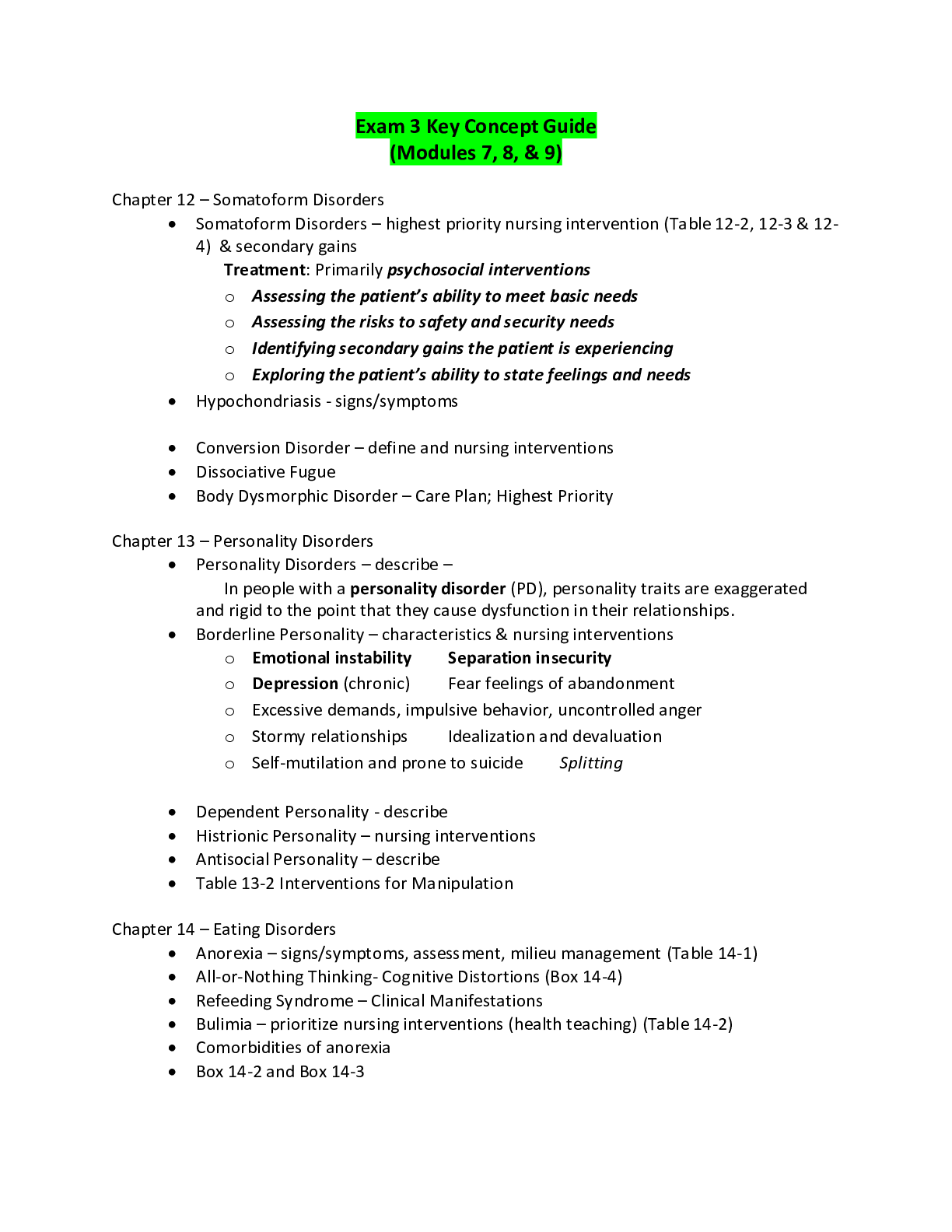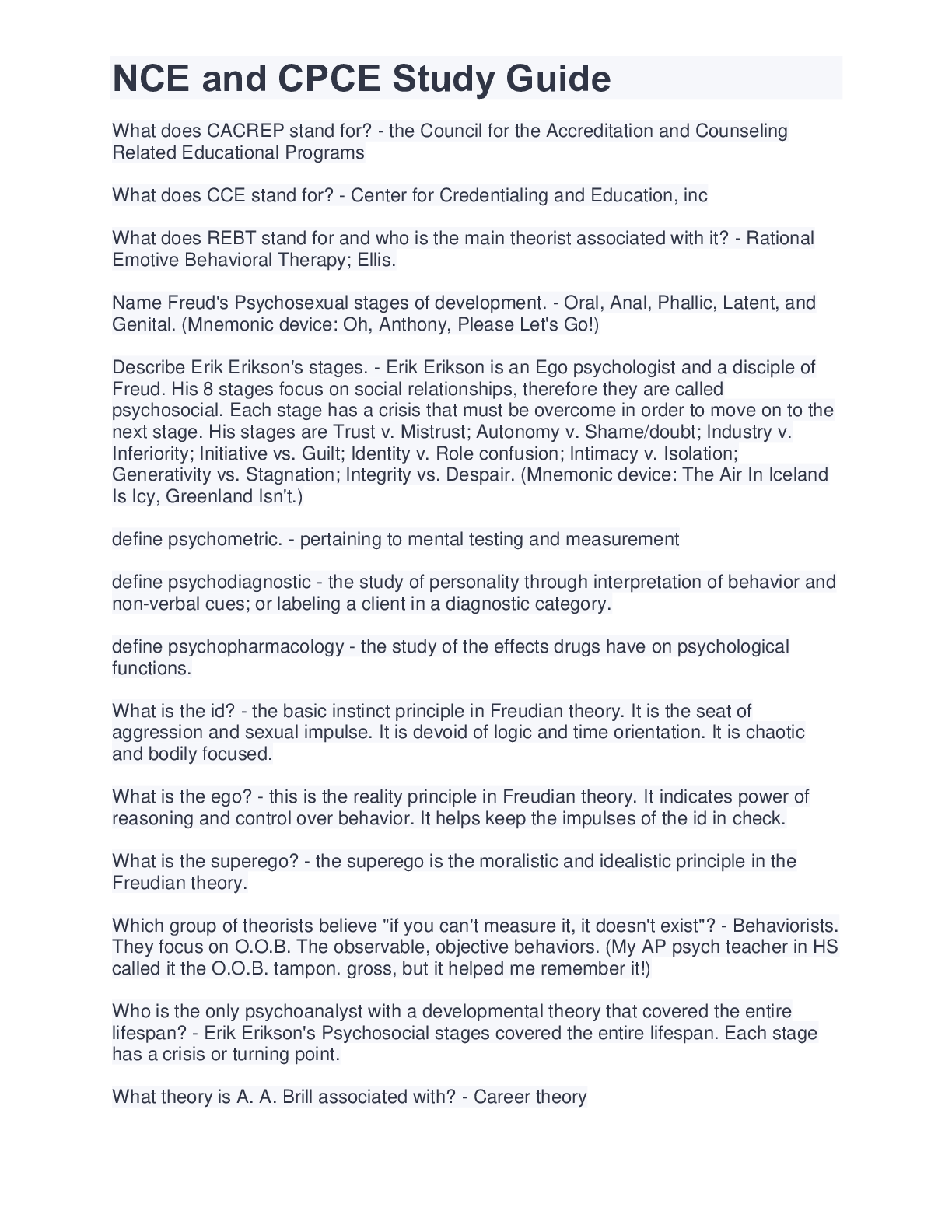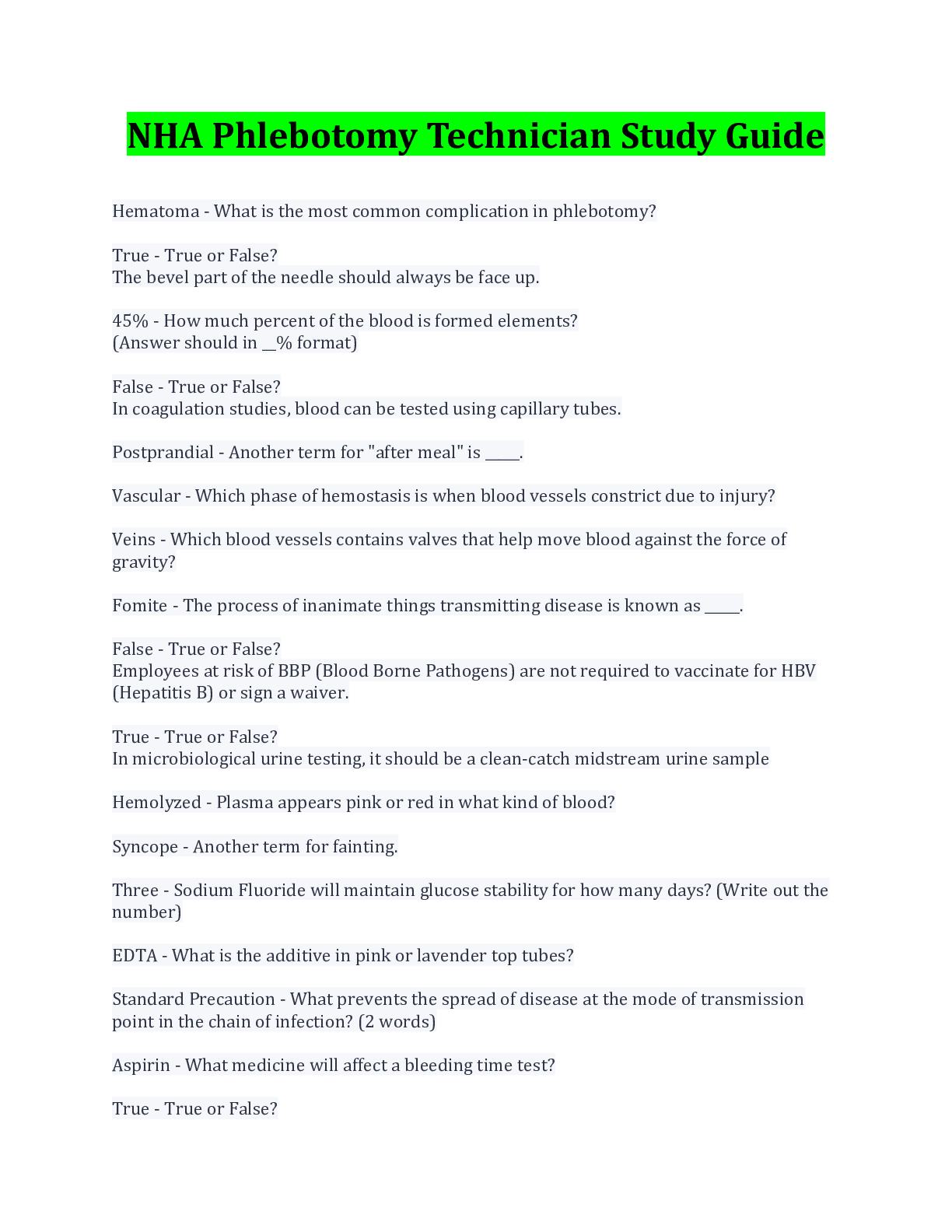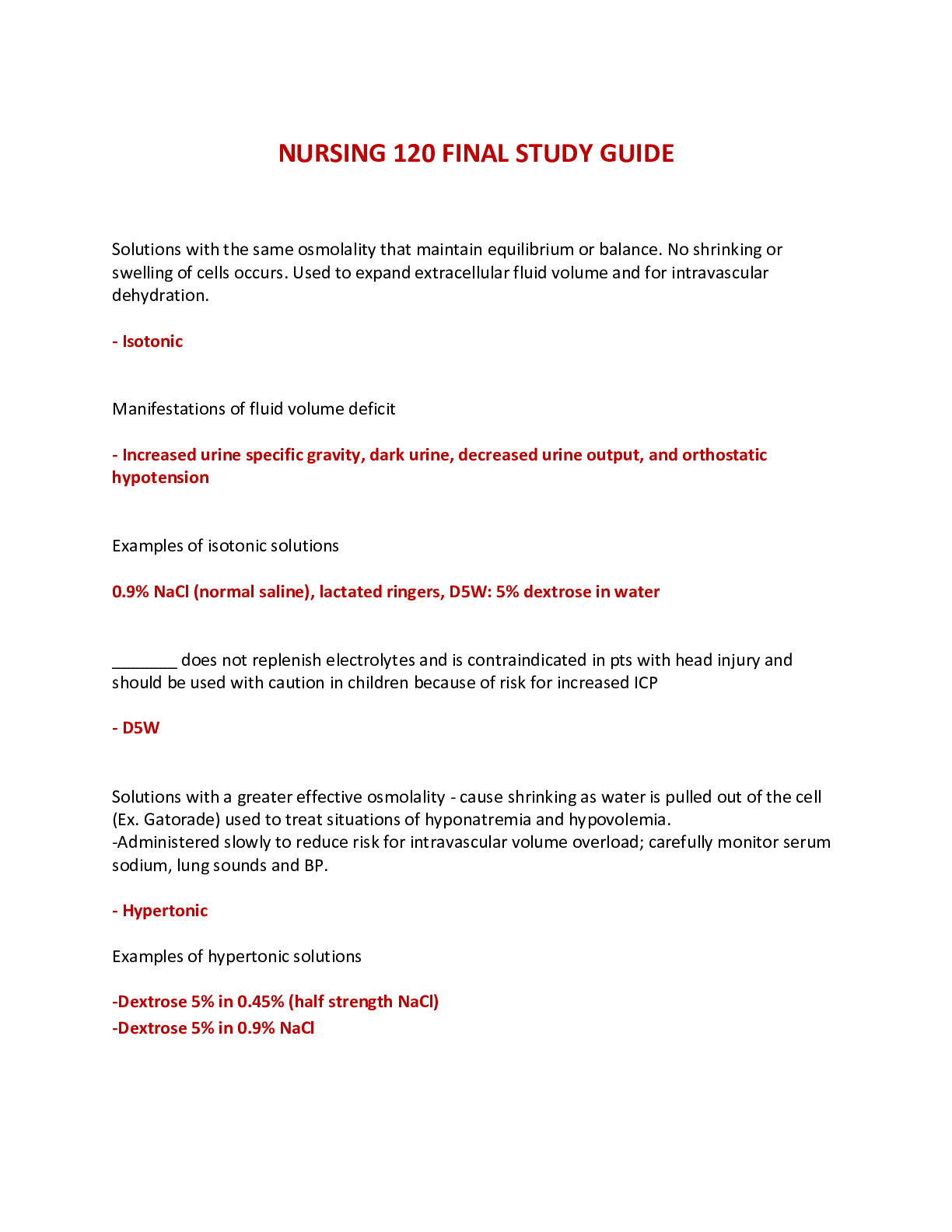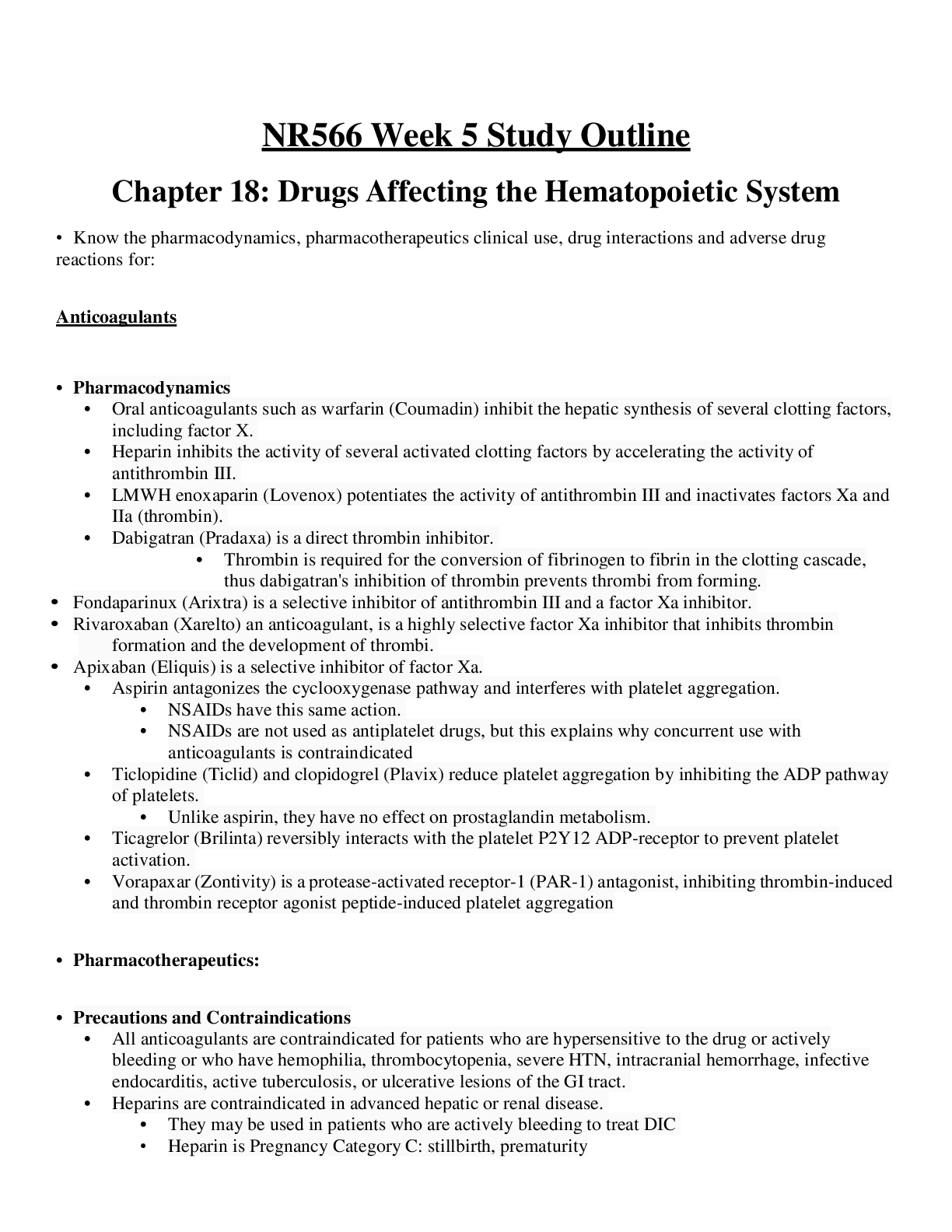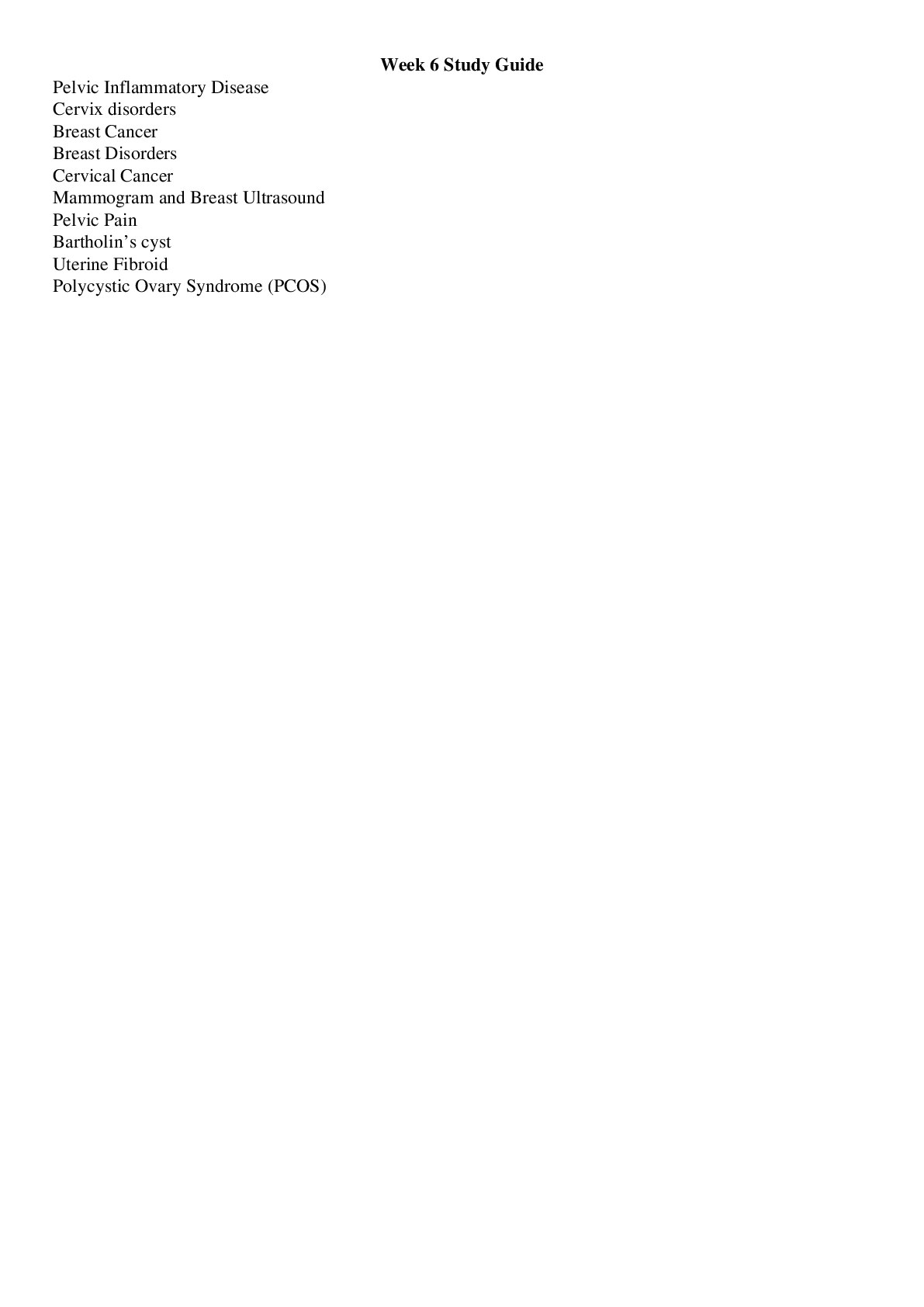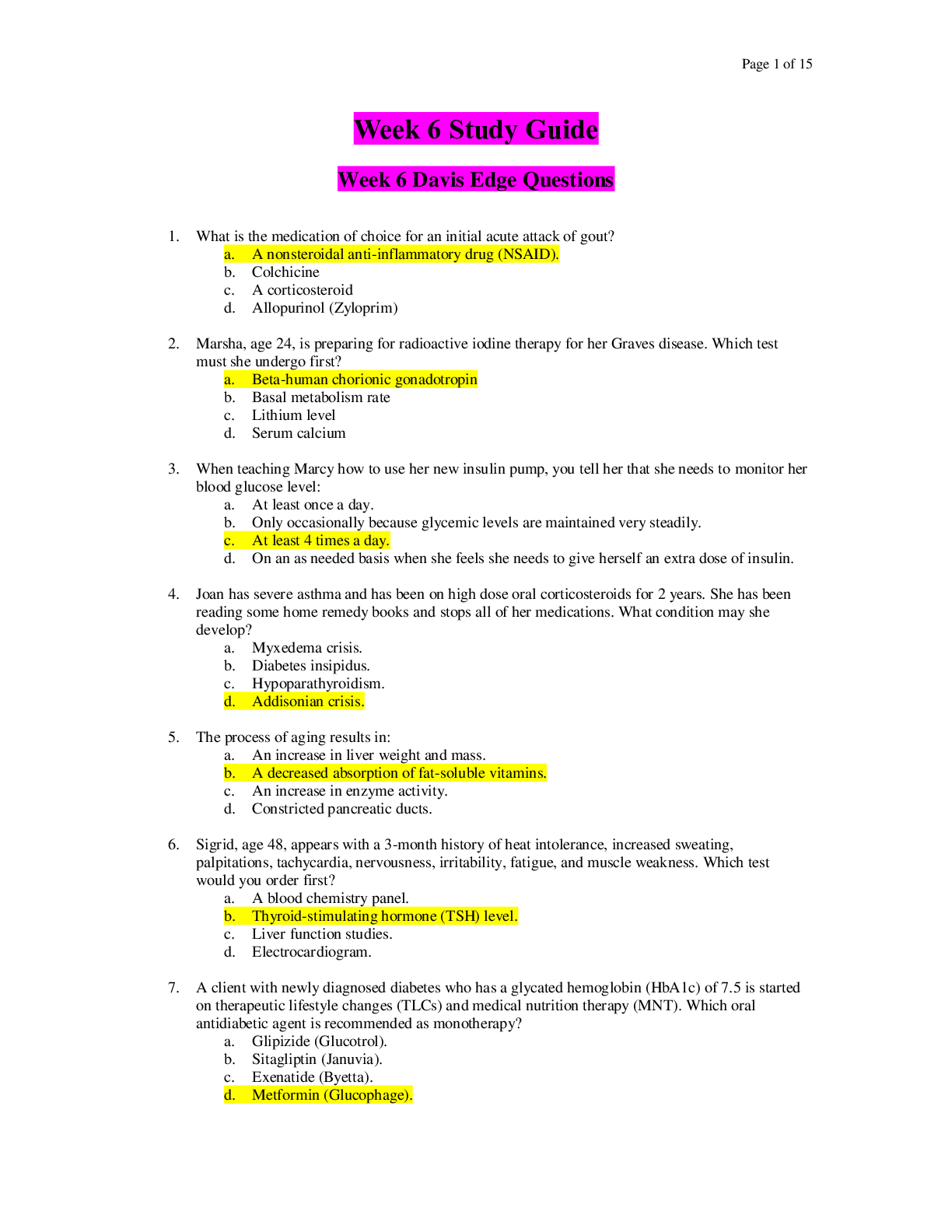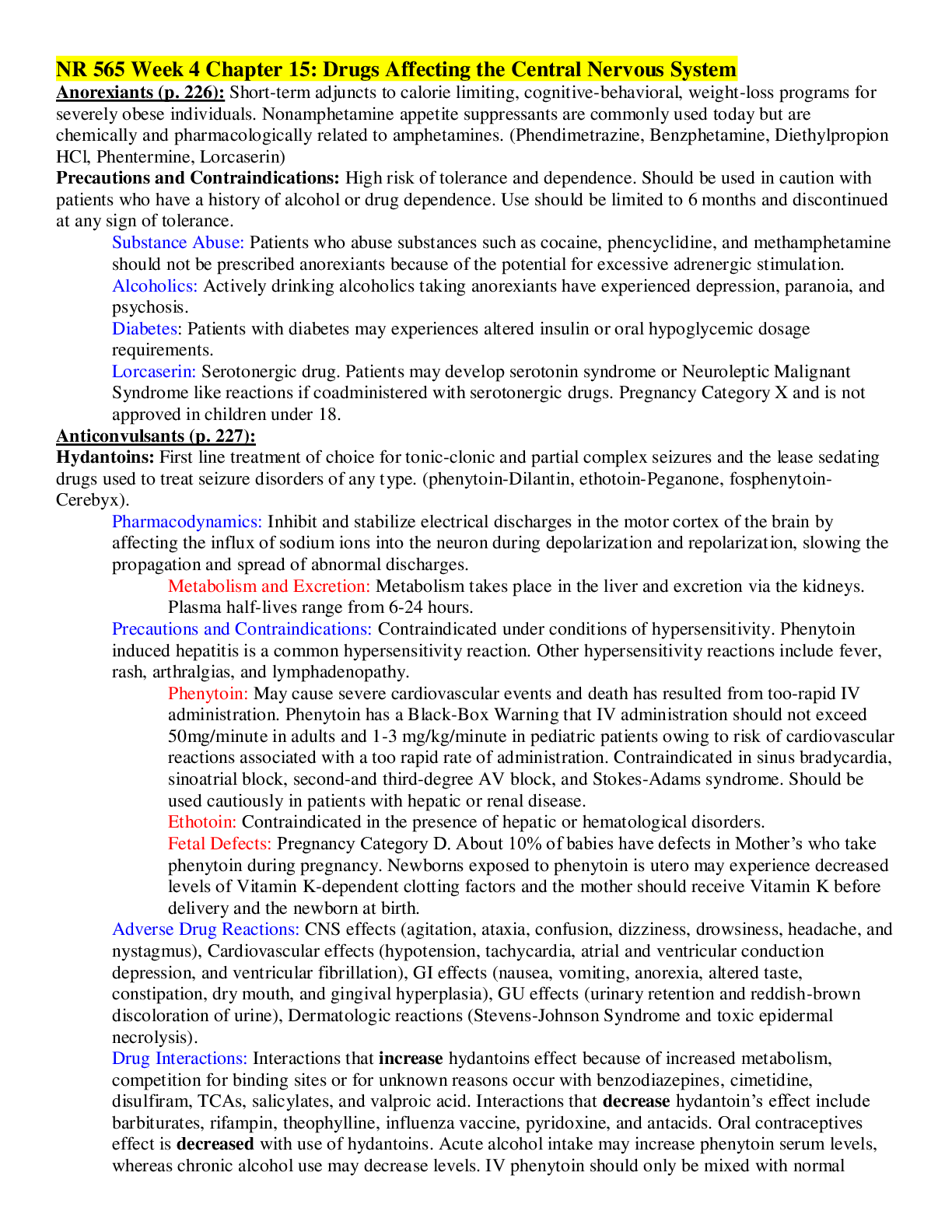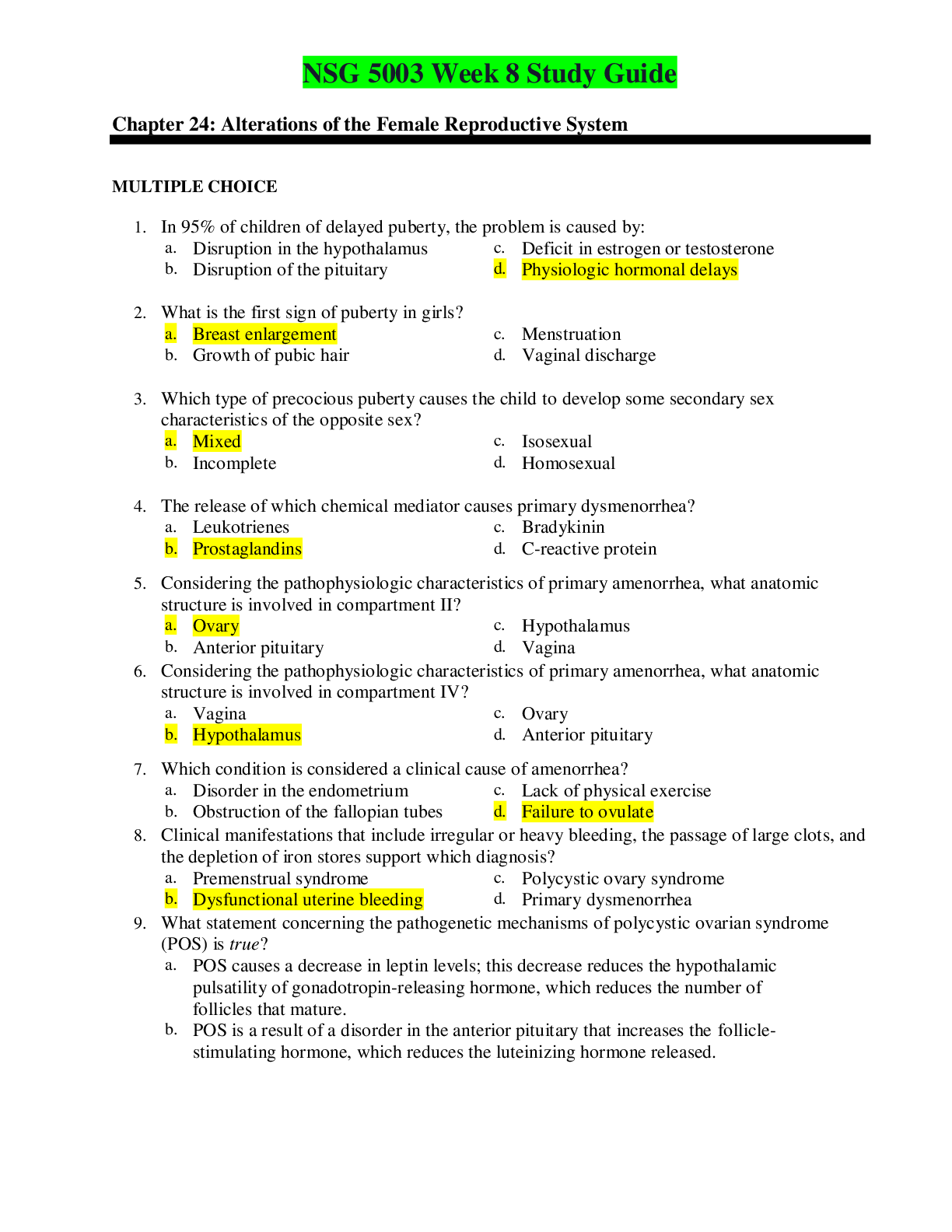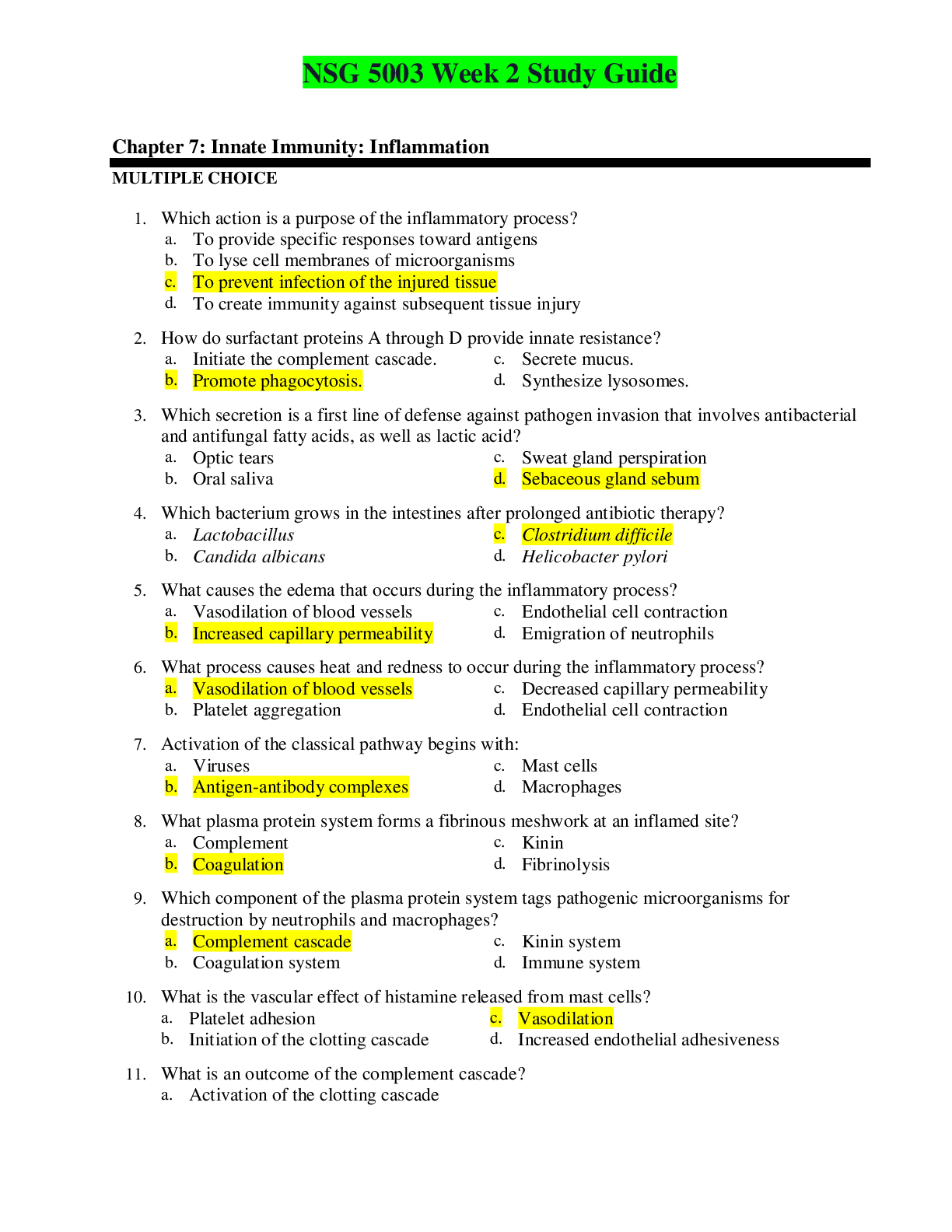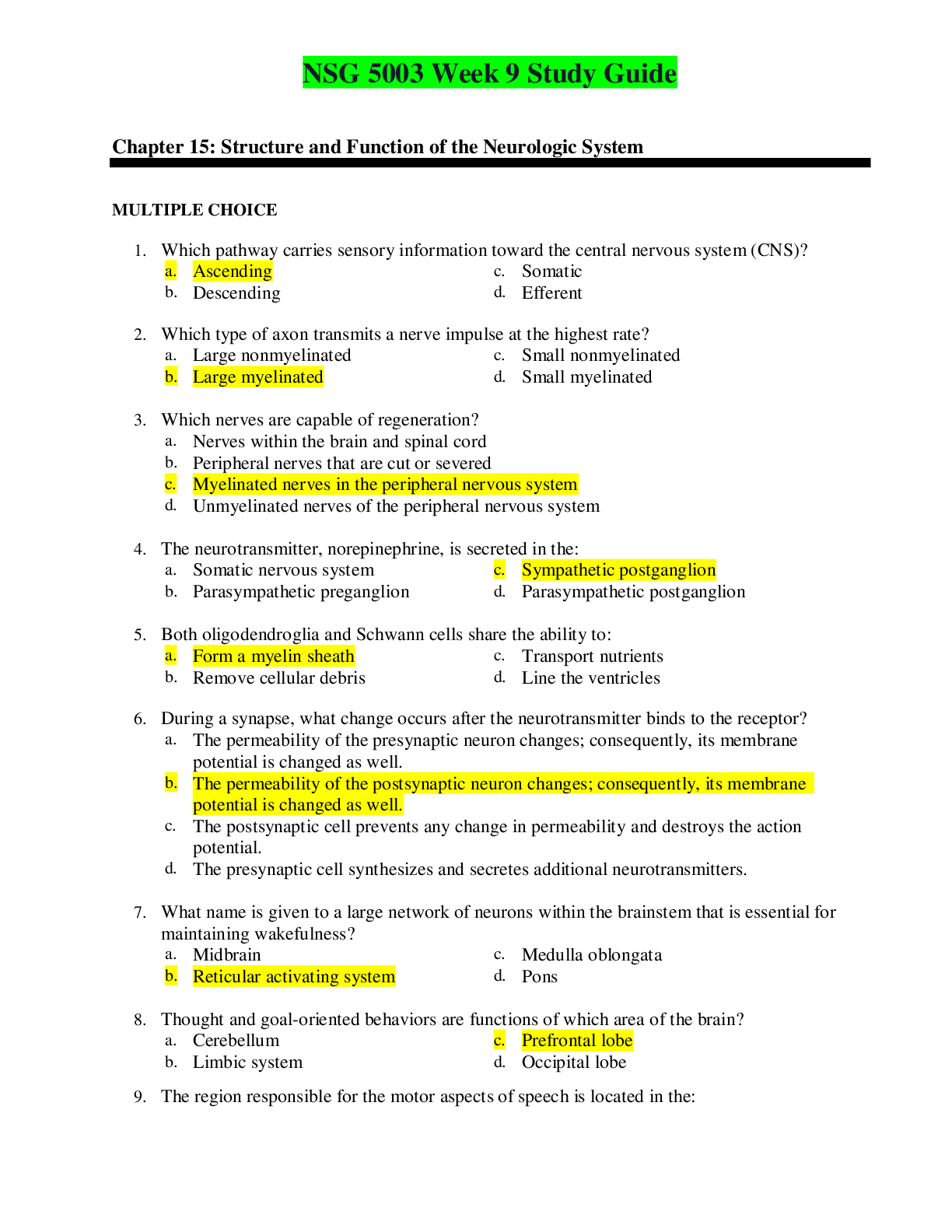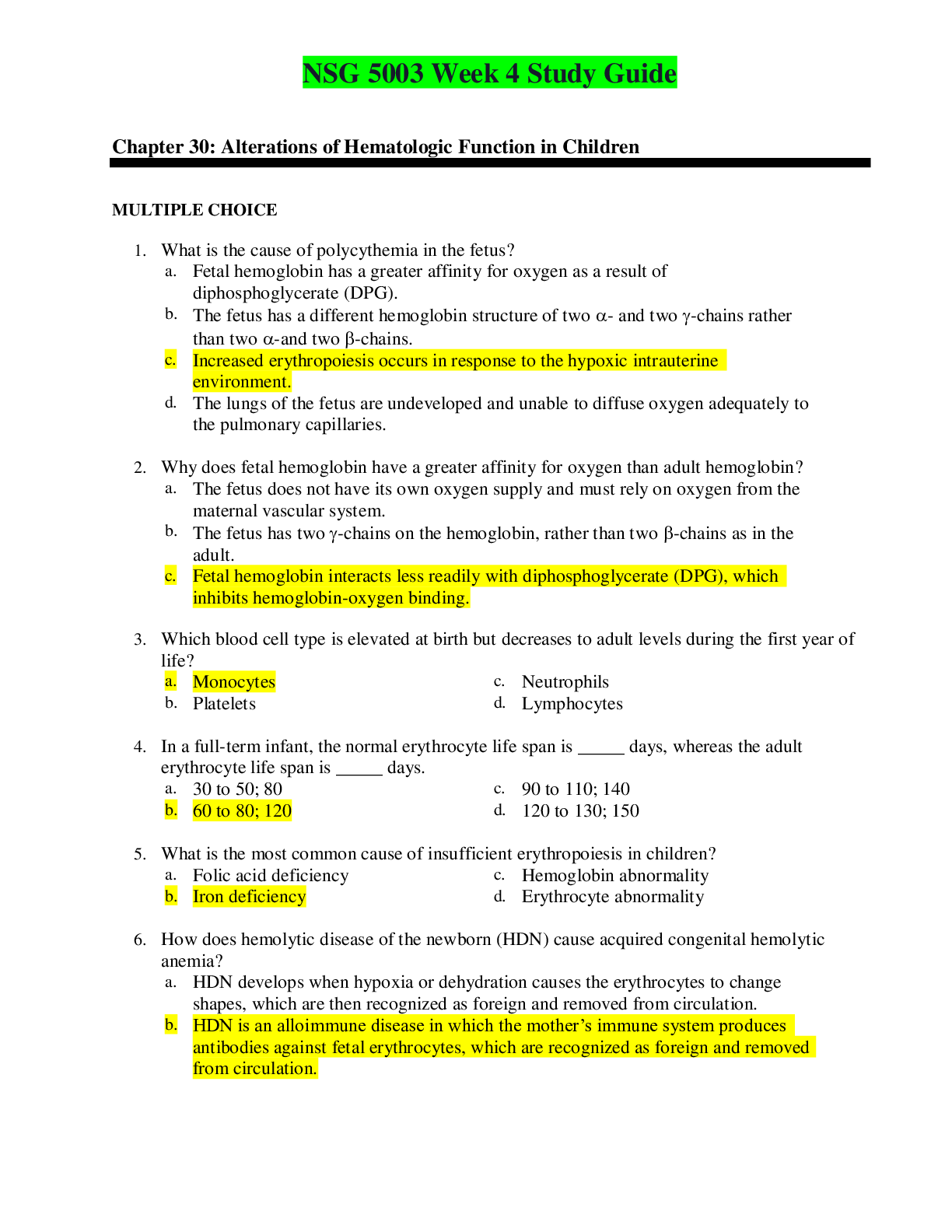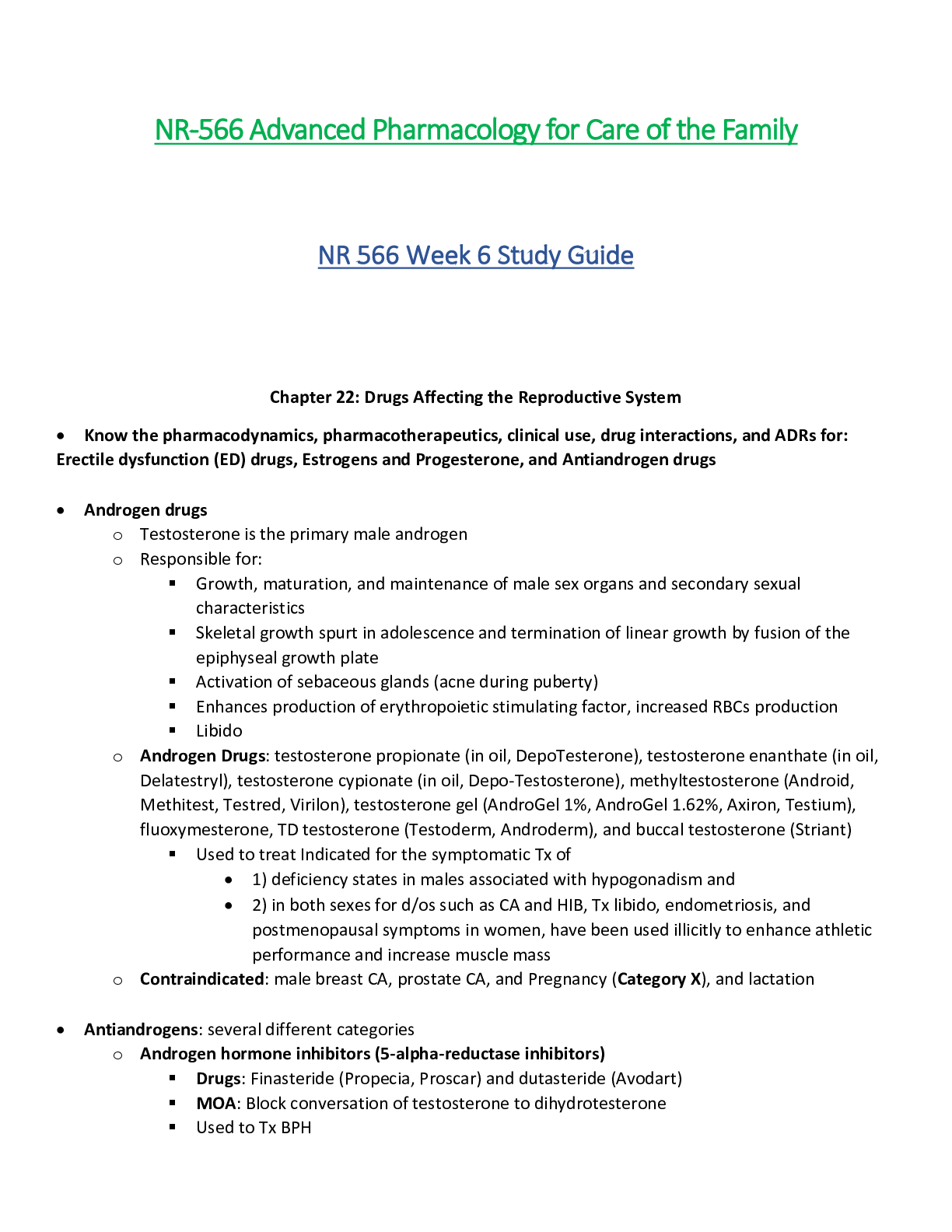*NURSING > STUDY GUIDE > NSG 5003 Week 6 Study Guide - Chapter 27 - 30 (All)
NSG 5003 Week 6 Study Guide - Chapter 27 - 30
Document Content and Description Below
NSG 5003 Week 6 Study Guide Chapter 27: Structure and Function of the Hematologic System MULTIPLE CHOICE 1. What is the most abundant class of plasma protein? 2. What is the effect of ... low plasma albumin? 3. What is the life span of an erythrocyte (in days)? 4. Which statement concerning erythrocytes is true? 5. Granulocytes that contain granules of vasoactive amines, such as histamine, are called: 6. Which of the following are formed elements of the blood that are not cells but are disk-shaped cytoplasmic fragments essential for blood clotting? 7. Blood cells that differentiate into macrophages are known as: 8. Without prior exposure to an antigen, which cells are able to destroy some types of tumor cells and some virus-infected cells? 9. What is the life span of platelets (in days)? 10. Fetal hematopoiesis occurs in which structure? 11. What is the consequence of a splenectomy? 12. During an infection, why do lymph nodes enlarge and become tender? 13. Which blood cells are the chief phagocytes involved in the early inflammation process? 14. Which blood cells are biconcave in shape and have the capacity to be reversibly deformed? 15. Which hemoglobin is made from oxidized ferric iron (Fe3+) and lacks the ability to bind oxygen? 16. The absence of parietal cells would prevent the absorption of an essential nutrient necessary to prevent which type of anemia? 17. Which nutrients are necessary for the synthesis of DNA and the maturation of erythrocytes? 18. Which nutrients are necessary for hemoglobin synthesis? 19. Recycling of iron from erythrocytes is made possible by which of the following? 20. By which structure are mature erythrocytes removed from the bloodstream? 21. Which substance is used to correct the chronic anemia associated with chronic renal failure? 22. What is the role of thromboxane A (TXA2) in the secretion stage of hemostasis? 23. Which of the following is the role of nitric oxide (NO) in hemostasis? 24. The drug heparin acts in hemostasis by which processes? 25. What is plasmin’s role in the clotting process? 26. What does polycythemia at birth indicate? 27. Where are Kupffer cells located? 28. Where are Langerhans cells found? 29. What is the role of collagen in the clotting process? 30. Which form of iron (Fe) can be used in the formation of normal hemoglobin? 31. Where are alveolar macrophages found? 32. What changes to the hematologic system is related to age? 33. What is the function of erythrocytes? Chapter 28: Alterations of Erythrocyte Function MULTIPLE CHOICE 1. What term is used to describe the capacity of some erythrocytes to vary in size, especially in relationship to some anemias? 2. What is the fundamental physiologic manifestation of anemia? 3. The paresthesia that occurs in vitamin B12 deficiency anemia is a result of which of the following? 4. Which of the following describes how the body compensates for anemia? 5. Which of the following is classified as a megaloblastic anemia? 6. Deficiencies in folate and vitamin B12 alter the synthesis of which of the following? 7. The underlying disorder of which anemia is a result of the defective secretion of the intrinsic factor, which is essential for the absorption of vitamin B12? 8. After a person has a subtotal gastrectomy for chronic gastritis, which type of anemia will result? 9. What causes the atrophy of gastric mucosal cells that result in pernicious anemia? 10. Which statement best describes a Schilling test? 11. What is the treatment of choice for pernicious anemia (PA)? 12. Which condition resulting from untreated pernicious anemia (PA) is fatal? 13. How is the effectiveness of vitamin B12 therapy measured? 14. Which statement about folic acid is false? 15. Which anemia produces small, pale erythrocytes? 16. Which type of anemia is characterized by fatigue, weakness, and dyspnea, as well as conjunctiva of the eyes and brittle, concave nails? 17. What is the most common cause of iron deficiency anemia (IDA)? 18. Continued therapy of pernicious anemia (PA) generally lasts how long? 19. Sideroblastic anemia can occasionally result from an autosomal recessive transmission inherited from which relative? 20. Clinical manifestations of mild-to-moderate splenomegaly and hepatomegaly, bronze-colored skin, and cardiac dysrhythmias are indicative of which anemia? 21. Considering sideroblastic anemia, what would be the expected effect on the plasma iron levels? 22. In aplastic anemia (AA), pancytopenia develops as a result of which of the following? 23. What is the most common pathophysiologic process that triggers aplastic anemia (AA)? 24. An allogenic bone marrow transplantation remains the preferred method for treating which anemia? 25. Which statement is true regarding warm autoimmune hemolytic anemia? 26. When considering hemolytic anemia, which statement is true regarding the occurrence of jaundice? 27. Erythrocyte life span of less than 120 days, ineffective bone marrow response to erythropoietin, and altered iron metabolism describe the pathophysiologic characteristics of which type of anemia? 28. What is the primary cause of the symptoms of polycythemia vera? 29. Treatment for polycythemia vera involves which of the following? 30. Considering iron replacement therapy prescribed for iron deficiency anemia, who is likely to require long-term daily maintenance dosage? 31. Which statement is true regarding the physical manifestations of vitamin B12 deficiency anemia? Chapter 29: Alterations of Leukocyte, Lymphoid, and Hemostatic Function MULTIPLE CHOICE 1. What change is observed in leukocytes during an allergic disorder (type I hypersensitivity) often caused by asthma, hay fever, and drug reactions? 2. In infectious mononucleosis (IM), what does the Monospot test detect? 3. Which description is consistent with acute lymphocytic leukemia (ALL)? 4. Which description is consistent with chronic myelogenous leukemia (CML)? 5. Which description is consistent with chronic lymphocytic leukemia (CLL)? 6. Which electrolyte imbalance accompanies multiple myeloma (MM)? 7. Reed-Sternberg (RS) cells represent malignant transformation and proliferation of which of the following? 8. Local signs and symptoms of Hodgkin disease–related lymphadenopathy are a result of which of the following? 9. Which virus is associated with Burkitt lymphoma in African children? 10. Which term is used to describe a red-purple discoloration caused by diffuse hemorrhage into the skin tissue? 11. Which statement best describes heparin-induced thrombocytopenia (HIT)? 12. Immune thrombocytopenia (ITP) is a(n) _____ condition in adults and a(n) _____ condition in children. 13. Vitamin _____ is required for normal clotting factor synthesis by the _____. 14. What is the most common cause of vitamin K deficiency? 15. Which disorder is described as an unregulated release of thrombin with subsequent fibrin formation and accelerated fibrinolysis? 16. In disseminated intravascular coagulation (DIC), what activates the coagulation cascade? 17. Which proinflammatory cytokines are responsible for the development and maintenance of disseminated intravascular coagulation (DIC)? 18. In disseminated intravascular coagulation (DIC), what are the indications of microvascular thrombosis? 19. What is the most reliable and specific test for diagnosing disseminated intravascular coagulation (DIC)? 20. What term is used to identify thrombi that occlude arterioles and capillaries and are made up of platelets with minimal fibrin and erythrocytes? 21. Which of the following is characterized by what is referred to as pathognomonic pentad of symptoms? 22. Which statement relates to immune thrombocytopenic purpura (ITP)? ] 23. When the demand for mature neutrophils exceeds the supply, immature neutrophils are released indicating: 24. Hodgkin disease is characterized by the presence of which of the following? Chapter 30: Alterations of Hematologic Function in Children MULTIPLE CHOICE 1. What is the cause of polycythemia in the fetus? 2. Why does fetal hemoglobin have a greater affinity for oxygen than adult hemoglobin? 3. Which blood cell type is elevated at birth but decreases to adult levels during the first year of life? 4. In a full-term infant, the normal erythrocyte life span is _____ days, whereas the adult erythrocyte life span is _____ days. 5. What is the most common cause of insufficient erythropoiesis in children? 6. How does hemolytic disease of the newborn (HDN) cause acquired congenital hemolytic anemia? 7. Erythroblastosis fetalis is defined as an: 8. An infant’s hemoglobin must fall below ___ g/dl before signs of pallor, tachycardia, and systolic murmurs occur. 9. Which vitamin improves the absorption of oral iron taken to treat iron deficiency anemia in children? 10. Hemolytic disease of the newborn (HDN) can occur if the mother: 11. When diagnosed with hemolytic disease of the newborn (HDN), why does the newborn develop hyperbilirubinemia after birth but not in utero? 12. Fetuses who do not survive anemia in utero are usually stillborn with gross edema of the entire body. Which term is used to identify this condition? 13. What is the name of the disorder in which levels of bilirubin remain excessively high in the newborn and are deposited in the brain? 14. What treatment prevents the development of kernicterus in an infant born with hemolytic disease of the newborn (HDN)? 15. Glucose 6-phosphate dehydrogenase (G6PD) deficiency is what type of inherited disorder? 16. Sickle cell disease is classified as a(an): 17. Hemoglobin S (HbS) is formed in sickle cell disease as a result of which process? 18. Sickle cell disease (SCD) is what type of inherited disorder? 19. What is the reason most children diagnosed with sickle cell anemia are not candidates for either bone marrow or stem cell transplants? 20. Which manifestations of vasoocclusive crisis are associated with sickle cell disease (SCD) in infants? 21. What is the chance with each pregnancy that a child born to two parents with the sickle trait will have sickle cell disease (SCD)? 22. Which type of anemia occurs as a result of thalassemia? 23. What is the fundamental defect that results in beta-thalassemia major? 24. The alpha- and beta-thalassemias are considered what types of inherited disorder? 25. Hemophilia B is caused by a deficiency of which clotting factor? 26. Hemophilia A is considered to be what type of inherited disorder? 27. Which disease is an autosomal dominant inherited hemorrhagic disease? 28. Idiopathic thrombocytopenic purpura (ITP) is an autoimmune process involving antibodies attacking which type of cells? 29. Which disorder results in decreased erythrocytes and platelets with changes in leukocytes and has clinical manifestations of pallor, fatigue, petechiae, purpura, bleeding, and fever? 30. When does fetal erythrocyte production shift from the liver to the bone marrow? 31. Which disease is caused by clotting factor VIII deficiency and is an autosomal dominant trait? 32. Which type of hemophilia affects only men? 33. Which hemophilia occurs equally in both men and women? 34. During childhood, when is dietary iron deficiency commonly diagnosed? 35. What is the significance of hyperdiploidy when diagnosing and treating leukemia? [Show More]
Last updated: 1 year ago
Preview 1 out of 15 pages

Buy this document to get the full access instantly
Instant Download Access after purchase
Add to cartInstant download
We Accept:

Also available in bundle (1)

NSG 5003 STUDY GUIDES
Week 4 Study Guide - Chapter 30 -32| Week 9 Study Guide - Chapter 15, 17 -20|Week 2 Study Guide - Chapter 7 - 11|Study Guide - Chapter 1, 2 & 3| Week 6 Study Guide - Chapter 27 - 30|Week 8 Study Guide...
By Ajay25 3 years ago
$42
7
Reviews( 0 )
$16.00
Document information
Connected school, study & course
About the document
Uploaded On
Feb 16, 2021
Number of pages
15
Written in
Additional information
This document has been written for:
Uploaded
Feb 16, 2021
Downloads
0
Views
65

